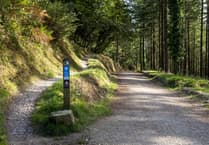I walked the mile downhill to Hepwell Bridge as I wanted to look around the nearby disused quarry to see what was in bloom. Hepwell Quarry used to supply stone for building hedges alongside new and widened roads and I can remember, some forty five years ago, my father helped build the hedge beside the road at Merrymeet, using stone from Hepwell.
What amazed me in the now overgrown quarry was the large amount of yellow perforate St John’s wort – Hypericum perforatum – flowers still in bloom albeit on their way out. The underside of their oval leaves are covered in tiny translucent dots as opposed the plain oval leaves of their cousin, the imperforate St John’s wort – Hypericum maculatum.
Talking about St John’s wort, I was watching University Challenge a few days ago and when one of the teams got the starter question correct, their three following questions for five points each, were to name the plants in three paintings. First was mistletoe. Their answer after a lot of conferring was Holly. Second painting was St John’s wort. Their answer aconite. Wrong again. Third picture was foxglove. After a lot of conferring they answered “That must be aconite”. Wrong for the third time.
Why is it that this team beat all their ‘classmates’ to appear on television and each one of them could tell you why Socrates chose to take his own life in 399 BC but could not recognise a foxglove? Surely the names of common flowers should have been learnt when they were attending primary school. This is why I applaud the people who planted all the flowers in St Martin’s Churchyard, Castle Park and a field at Pengover. Hopefully when classes of school children visit these sites, they will learn all the names of the flowers that they see.
Anyway, back to Hepwell Quarry. There were lots of butterfly bushes – Buddleja davidii – with their long purple flowers that were, as its name suggests, attracting lots of butterflies. I saw red admirals, peacocks, small whites and a couple of speckled woods that were performing their own brand of aerial combat.
Growing right in among the brambles was an umbelliferae plant (Carrot family) with a long stalk that was topped with hundreds of seeds. I couldn’t identify it as I could see no leaves on it and I didn’t want to venture in among the brambles. I have a great respect for brambles because some years ago I tripped over a bramble runner, dislocated my shoulder and spent four months off work. But these branches of seeds looked really lovely in the sunlight.
Growing near the river were some policeman’s helmet plants or Himalayan balsam – Impatiens glandulifera – with purple flowers and some with white. Once again, a plant introduced from the Himalayas some two hundred years ago as a garden flower, but as their explosive seed capsules can throw their seeds up to ten metres away, the plants soon escaped into the wild to populate waste areas near water. Therefore, this very rampant invader is now considered a pest, often over running our native flora.




